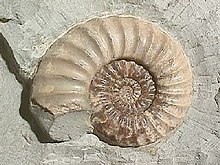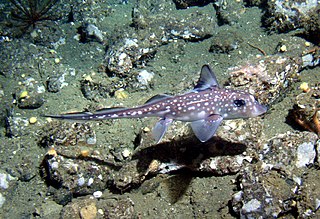
Chimaeras are cartilaginous fish in the order Chimaeriformes, known informally as ghost sharks, rat fish, spookfish, or rabbit fish; the last three names are not to be confused with rattails, Opisthoproctidae, or Siganidae, respectively.
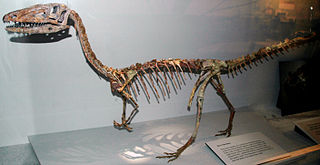
Coelophysoidea were common dinosaurs of the Late Triassic and Early Jurassic periods. They were widespread geographically, probably living on all continents. Coelophysoids were all slender, carnivorous forms with a superficial similarity to the coelurosaurs, with which they were formerly classified, and some species had delicate cranial crests. Sizes range from about 1 to 6 m in length. It is unknown what kind of external covering coelophysoids had, and various artists have portrayed them as either scaly or feathered. Some species may have lived in packs, as inferred from sites where numerous individuals have been found together.
The Hettangian is the earliest age and lowest stage of the Jurassic Period of the geologic timescale. It spans the time between 201.3 ± 0.2 Ma and 199.3 ± 0.3 Ma. The Hettangian follows the Rhaetian and is followed by the Sinemurian.

In the geologic timescale, the Sinemurian is an age and stage in the Early or Lower Jurassic Epoch or Series. It spans the time between 199.5 ±0.3 Ma and 192.9 ±0.3 Ma. The Sinemurian is preceded by the Hettangian and is followed by the Pliensbachian.
Gigantoscelus is a dubious genus of basal sauropodomorph dinosaur from the Early Jurassic of South Africa.
Lusitanosaurus is a genus of large basal thyreophoran dinosaur from the Sinemurian stage of Early Jurassic of Portugal. It is the second example of the group from the Lower Jurassic of Europe and it is the oldest known dinosaur from the Iberian Peninsula. It is based on a large left maxilla with teeth that was lost in the fire at Museu Nacional de História Natural e da Ciência, Lisbon, in 1978.

Cloford Quarry is a 39.92-hectare (98.6-acre) geological Site of Special Scientific Interest to the south of the A361 approximately 350 metres (1,150 ft) north of the hamlet of Cloford and 1 kilometre (0.6 mi) west of Nunney on the Mendip Hills in Somerset. It was notified in 1994.
Aegasteroceras is an extinct cephalopod genus from the Lower Jurassic belonging to the arietitid subfamily Asteroceratinae. The shell of Aegasteroceras is evolute with curve forward and meet at a broad low ventral keel. Aegasteroceras, named by Spath, 1925, has been found in the Sinemurian of England.

Excalibosaurus is a monotypic genus of marine prehistoric reptiles (ichthyosaurs) that lived during the Sinemurian stage of the Early Jurassic period in what is now England. It is characterized by the extreme elongation of the rostrum, with the lower jaw about three-quarters the length of the upper jaw, giving the animal a swordfish-like look. The only known species is Excalibosaurus costini.
Pradhania is a genus of massospondylid sauropodomorph dinosaur from the Sinemurian-age Upper Dharmaram Formation of India. It was first named by T. S. Kutty, Sankar Chatterjee, Peter M. Galton and Paul Upchurch in 2007 and the type species is Pradhania gracilis. It was a sauropodomorph of modest size, only about four meters (13 ft) long, and is known from fragmentary remains. It was originally regarded as a basal sauropodomorph but new cladistic analysis performed by Novas et al., 2011 suggests that Pradhania is a massospondylid. Pradhania presents two synapomorphies of Massospondylidae recovered in their phylogenetic analysis.
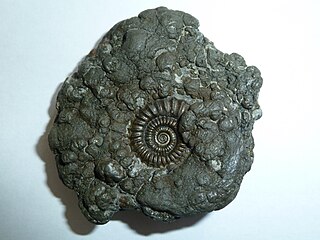
Promicroceras is an extinct ammonite genus from the upper Sinemurian of Europe, named by Leonard Spath in 1925. Promicroceras is included in the family Eoderoceratidae, which is part of the ammonitid superfamily Eoderoceratoidea.
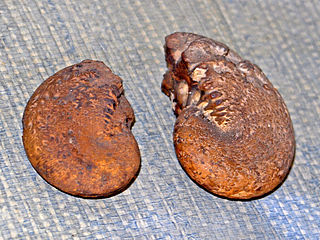
Phylloceratidae is the predominant family of the Phylloceratina with some 15 or more genera found in rocks ranging from the Lower Jurassic to the Upper Cretaceous. Members of the Phylloceratidae are characterized by smooth, involute shells with very thin walls. Many are covered with fine growth lines but are usually without ribbing. Sutures are complex with the major and minor branches of the saddles with phylloid or spatulate endings.
Leonard Frank Spath FRS was a British geologist specialising in malacology and ammonitology.

Oxynoticeratidae is a family of true ammonites included in the superfamily Psiloceratoidea.

Coleia is an extinct genus of decapods in the group Polychelida that lived from the Late Triassic to the Late Jurassic. It was described by Broderip in 1835, and the type species is C. antiqua. A new species, C. martinlutheri, which existed during the Sinemurian of what is now Germany, was described by Günter Schweigert and Werner Ernst in 2012.

Echioceratidae is an extinct family of ammonites that lived during Sinemurian stage of Early Jurassic.
The Allgäu Formation is a geologic formation in Austria, Germany and Slovakia. It preserves fossils dating back to the Hettangian to Sinemurian stages of the Early Jurassic period, or Raricostatum to Obtusum in the regional stratigraphy. Initially and formally defined by Jacobshagen (1965). The Allgäu Formation is formerly known as spotted marls (Lias-Fleckenmergel) and spotted marly limestones (Fleckenkalk). The formation is represented by dark-grey bioturbated limestones and marlstone interbeds. It represents basinal hemipelagic facies common in Alpine Tethys regions of Alps, Carpathians and other mountain ranges. Several horizons of the formation are particularly rich in ammonite fauna.

Dermapteridae is an extinct family of earwigs known from the Late Triassic to Mid Cretaceous, it is part of the extinct suborder Archidermaptera, alongside Protodiplatyidae and Turanovia. It was first named as a subfamily by Vishniakova in 1980, and elevated to family status by Engel in 2003 without discussion.

Orthophlebiidae is an extinct family of scorpionflies known from the Triassic to Cretaceous, belonging to the superfamily Panorpoidea. The family is poorly defined and is probably paraphyletic, representing many primitive members of Panorpoidea with most species only known from isolated wings, and has such been considered a wastebasket taxon.
Protorthophlebia is an extinct genus of scorpionflies, known from the Triassic and Jurassic periods of Eurasia. It was originally considered a member of the family Orthophlebiidae, but was later placed as the only genus within the family Protorthophlebiidae within the superfamily Panorpoidea.
